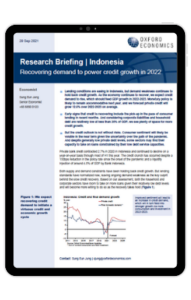Indonesia | Recovering demand to power credit growth in 2022

Private bank credit contracted 2.7% in 2020 in Indonesia and continued to decline on a year-on-year basis through most of H1 this year. The credit crunch has occurred despite a 150bps reduction in the policy rate since the onset of the pandemic and a liquidity injection of around 4.5% of GDP by Bank Indonesia.
What you will learn:
- Lending conditions are easing in Indonesia, but demand weakness continues to hold back credit growth. As the economy continues to recover, we expect credit demand to rise, which should feed GDP growth in 2022-2023. Monetary policy is likely to remain accommodative next year, and we forecast private credit will grow 12.6% over 2022-2023 on average.
- Early signs that credit is recovering include the pick-up in the pace of consumer lending in recent months. And considering corporate liabilities and household debt are relatively low at less than 20% of GDP, we see plenty of space for more credit growth.
- But the credit outlook is not without risks. Consumer sentiment will likely be volatile in the near term given the uncertainty over the path of the pandemic. And despite generally low private debt levels, some sectors may find their capacity to take on loans constrained by their low debt service capacities.
Tags:
Related Services

Post
Japan’s fiscal policy will remain loose, which increases risks to debt sustainabilit
We've changed our fiscal outlook for Japan in our December forecast round. We now expect the new government to set a primary deficit close to that of 2024, at 2%-3% of GDP for 2025-2027, instead of restoring a balanced budget by taking advantage of strong tax revenue. We assume higher bond yields will force the government to take measures to reduce the deficit from 2028.
Find Out More
Post
US Key Themes 2026: Exceptionalism amid fragmentation
US exceptionalism is alive and well, and that won't change in 2026.
Find Out More